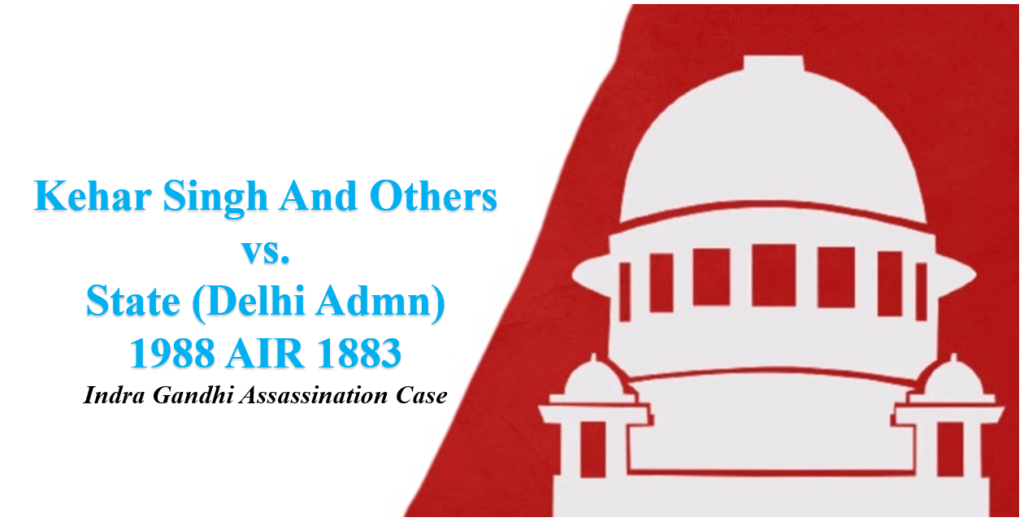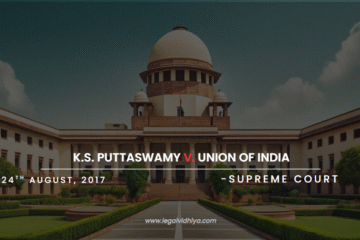
KEHAR SINGH AND OTHERS VS. STATE (DELHI ADMN) 1988
CITATION: 1988 AIR 1883, 1988 SCR Supl. (2) 24
IN THE SUPREME COURT OF INDIA
BENCH/JUDGE: Oza, G.L. (J)
APPELLANT/PETITIONER – KEHAR SINGH AND OTHERS
RESPONDENT/DEFENDANT- STATE (DELHI ADMINISTRATION)
BACKGROUND:
One of the important and well known cases of all time. The Kehar Singh case is famously known as the Indira Gandhi assassination case. In the year 1984, on 31st October, The then prime minister of India Mrs. Indira Gandhi was brutally shot and assassinated by her own Sikh security counsels. The case earned huge attention at that time since Indira Gandhi was the leading lady of India. The case had been a heated topic for years and even today. This is the rarest of rare case where All the accused were hanged after the pronouncement of the judgment by the honorable Supreme Court. The sudden demise of PM Indira Gandhi was henceforth due to the operation blue star.
BRIEF FACTS: In 1984, the Indian Army started an operation known as ‘Operation Blue Star’ in which armed forces entered the golden temple of Amritsar to eliminate the terrorists. Operation Blue Star was a very big mission undertaken by the Indian Army to eliminate impending armed terrorists hiding inside the Golden Temple. Operation Blue Star was a solution put forth by Indira Gandhi to stabilize the situation of ongoing disputes in Punjab. The terrorists set up their base at the Harmandir Sahib complex and it was bring into being out that they had machine guns and other powerful weapons.
In 1984, in the month of June, the Indian Army began an operation called Operation Bluestar
to eliminate some terrorists who were hiding in the Golden Temple complex. To begin with it, the Indian Army had a well-organized plan to enter the temple complex area and detent the armed terrorists.
The Akal Takht was left dented after the completion of Operation Bluestar. This
hurt the sentiments of people belonging to the Sikh community. It hurt their religious feelings
and hence they held PM Indira Gandhi, responsible for the incident that took place. Sikh people rallied against Smt. Indira Gandhi publicly expressed their anger and resentment
towards her as she was liable for issuing orders to continue such an operation
On October 31, 1984, Indira Gandhi had an interview with an Irish reporter at her official residence located at Safdarjung. The two-building was connected by the narrow cemented pathway known as TMC Gate.
In the morning of 31st October, Indira Gandhi stepped out from her house. She was attended by her staff which included Head Constable Narayan Singh, Rameshwar Dayal, Assistant Sub. Inspector Nathuram, Attendant and R.K. Dhawan Special Assistant.
In carrying out their common intention, accused Beant Singh and Satwant Singh who had prior knowledge of the scheduled Programme of Mrs. Gandhi, planned their duties in such a way that Beant Singh would be present at the TMC gate and Satwant Singh in the TMC booth.
Accused Satwant Singh whose duty was on gate number 4, managed to get duty near TMC booth by fabricating the story that he has dysentery.
At the time, when Indira Gandhi along with the persons mentioned above passed beside the TMC gate, the accused Beant Singh who was ready with his loaded armed gun fired five rounds and Satwant Singh shot twenty-five bullets on Mrs. Gandhi, due to which she fell flat on the ground and was rushed towards AIIMS where she succumbed to death.
It was suspected that there were not only these 2 persons in the conspiracy. It was a cruel murder with a well-planned motive. This assassination of the highest order was done with the cryptic motive in a mind with the common intention. Another person who was alleged to be included in this conspiracy was Balwant Singh who was known to hold several rallies and protests against Mrs. Gandhi and had shown open resentment against her on several occasions for ‘Operation Bluestar’. It was also alleged that he was part of the conspiracy and also communicated his plans with Beant Singh to assassinate Mrs. Gandhi.
Another person who was allegedly involved in this conspiracy was Kehar Singh who was a religious Extremist. He was aggrieved because of Operation Bluestar which caused damage to Akal Takht in the Golden Temple Complex of Amritsar. He was said to influence Beant Singh who was his nephew by compelling him to listen to provocative, hatred-filled religious messages.
ISSUES INVOLVED:
Several issues were raised in this case. The Government of India constituted a commission under the Commission of Inquiry Act, 1952. There were several issues which were presented that were to be proved:
- Whether the crime could have been avoided and whether security forces that were in a job to protect Mrs. Gandhi and were responsible for the security of her were indulged in the commission of such a grave crime?
- Did the defences or flaws in the proper and secured arrangement of the security system play a crucial role in facilitating the commission of the crime?
- Whether there was any hidden conspiracy or whether any person, group of persons or any agency was responsible for the commission of this crime?
- Whether the President has the power, to hear a case based on its merits when the case has already been decided by the court , under Article 72 of the Indian Constitution
- Whether the trial in Tihar Jail was valid?
IMPORTANT ARGUMENTS
ARGUMENTS BY APPELLANT[1]
It was debated that article 21 of the Constitution guarantees speedy, open, and public trial, and holding the trial in Tihar jail violates this right, given under sec 327 of the code of criminal procedure.
The case is to be recorded in the camera. Camera trial is not crucial and it is nowhere given or defined in Section 327 of the Code of Criminal Procedure, 1973.
That the trial court has violated Article 19(1)(a) of the Indian Constitution by restricting public access to the judicial proceedings. There should not be any discrimination between the common citizens and between the media person. The court should follow the first come first serve basis. That the related documents and all the relevant materials related to the examination of the witnesses by the Thakkar committee were not made available and provided to the appellants. They are also entitled to the relevant material based on which they could construct their defences and could present them during the trial. There was no evidence that Kehar Singh took Beant Singh to Gurudwara and exposed him to provocative bhajans.
ARGUMENTS BY RESPONDANT[2]
The high court had the authority to fix the place of sitting and trial for the particular case if it had the authority to issue notification under section 9(6) of CrPC. It was also contended that the language of the Commission of Inquiry is protection and statements of witnesses are protected, confidential and cannot be revealed.
The court thus rejected the appeals of Satwant Singh and Kehar Singh and allowed the appeal of Balwant Singh. .
According to Section 327 of the CrPC, the provision of a fair and open trial for the public is given. An open place can be defined as any place where there is not any restriction for ordinary citizens to see. The court did not put any restrictions on the trial.
there was not any violation of Article 21 of the Constitution, in this case. There were no restrictions on the right to life of the accused and trial was held in a legalized manner.
No question regarding the absconding matter will arise as the examination of witnesses regarding the absconding matter wasn’t conducted.
The document which was found during the search and seizures from the personal belongings of Balwant Singh did not indicate any connection of him with Beant Singh and there was no indication that Balwant Singh was involved and had anything to do with the conspiracy. Although, it was written ‘felt like killing’ in the document. But, it cannot be interpreted as he was involved in the conspiracy.[3]
Hence, the court had concluded that Balwant Singh had good relations with Satwant Singh and Kehar Singh but, he was not involved in the conspiracy related to the assassination of Indira Gandhi due to lack of evidence against him.[4]
JUDGEMENT:
This gutless act which was committed by Indira Gandhi’s security counsels took her life in a very horrendous way. She was unarmed when she was attacked. Her trust that she had placed in her bodyguards was broken.
Section 194 of CrPC empowers the judge of the trial court to transfer the case to the High Court if it is necessary.
Section 6 of the Commission of Inquiry Act, stated that the statement of a witness is protected and cannot be used for self-incrimination. There are two restrictions to be given by the witness, the first one is Self Incrimination and other one is estoppel.
After hearing both the appeals, the court gave the verdict to acquit Balwant Singh as no proof or evidence was found against him. There was no evidence that proved that Balwant Singh had any intention to kill Mrs. Gandhi and no evidence could be found of his involvement in the conspiracy.
Indira Gandhi died as the result of injuries that were inflicted by Beant Singh and Satwant Singh by service revolver. It was a criminal conspiracy. Besides the evidence gathered through direct witnesses, the other evidence was also in corroboration with the post mortem report of the body, therefore the appeal of Satwant Singh was dismissed.
The findings of the trial court and high court were proven against Satwant Singh and the same was upheld by the Supreme Court. The charge of conspiracy against Kehar Singh and Satwant Singh has been proved without any reasonable doubt. As it is one of the rarest of rare cases so the death penalty was given to all the accused persons
CONCLUSION
The Indian judiciary witnessed and gave judgment to one of the very important case of 1980s. Indira Gandhi was not only the prime minister of India but was the leader elected by a gigantic amount of people legitimately, brutally murdered by the people who were on duty to protect her because of the decision taken by her, under the garb of her constitutional power.
It can be said that the Supreme Court, in this case, delivered justice by establishing the provisions of the Constitution and the validity of rights safeguarded under the Constitution. . The Indira Gandhi assassination case is one of the most crucial cases in the history of the Indian judiciary. It was the betrayal of the worst order by her own securities. This case holds a very important place in the history of the Indian democracy. This case has been marked forever in our minds.
- Seep Gupta, Kehar Singh & Ors vs. State (Delhi Admn.), available at https://blog.ipleaders.in/kehar-singh-ors-vs-state-delhi-admn/, last seen on 06/04/2023
Written by: Nandini Saikia, University Law College, Gauhati University




0 Comments